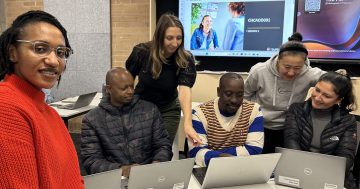Yong Zhao* says machines are better than most human foreign language learners at translation, so teaching languages should now focus on global competence.
 As ChatGPT and DALL-E go viral, hopes and warnings about artificial intelligence (or AI) are also growing.
As ChatGPT and DALL-E go viral, hopes and warnings about artificial intelligence (or AI) are also growing.
AI-based computer programs like ChatGPT can write essays and DALL-E can generate artistic images – in other words, it seems that computers can now do human work, humanly creative work.
While technology will continue to become more sophisticated, conversations about the implications of these two creative AI applications are wide ranging, affecting almost every aspect of human life, including education.
For example, what should the teaching of writing look like when machines can write? What is the nature of art education when machines can create art?
But there’s another set of AI-based computer programs that haven’t yet had as much attention but may have significant impact on foreign language education in our schools.
This is machine translation software that automatically translates text or speech from one language into another.
Machine translation has been in existence since the 1950s but has made significant progress over the last 70 years or so.
Popular machine translation tools probably include ones you already use – Google Translate, Microsoft Translator, DeepL, Alexa Translations and the list goes on.
These tools vary a great deal in terms of the number of languages they can translate, their ease of use and accuracy.
Some, like Google Translate, can translate over 100 languages, while others cover far fewer.
And the quality of translation can vary a lot – as does the ease of use and access.
But there’s an important conversation to have about the potential implications of machine translation – especially when it comes to the purpose, curriculum and teaching of foreign language education in schools.
One of the primary aims of foreign language education is to teach students to become competent in a language so that they can communicate with its native speakers.
So, not surprisingly, all curriculums in foreign language courses have an almost exclusive focus on helping students to develop competence in listening, speaking, reading and writing in that language.
Whatever teaching methods are used, the expectation is that students become proficient users of the language.
This expectation is one shared by teachers, school administrators, system leaders, parents and the public.
But the expectation is generally wishful thinking for the majority of students who may be taking a foreign language course voluntarily or as a requirement.
Despite the hard work of many teachers and a genuine interest and effort from many student, most of the students are far from competent after one to four (or even ten) school years.
Very few students can truly achieve native or near native speaker proficiency.
In comparison to today’s machine translation, which is far from perfect, a majority of students are unable to do as well as translation machines in communicating with native speakers of a language.
There are many reasons for the lack of development of true competence after so many years of studying the language, but three reasons are unchangeable.
Firstly, the amount of time of learning the target language is limited.
In most schools, the maximum number of hours per week is three to five class hours.
Assuming there’s 40 weeks in a school year, the total number of hours is 120 to 200 class hours, which amounts to about 80 to 130 learning hours which is far from the time needed to acquire proficiency in a second language.
Secondly, there’s typically no environment where a student can authentically speak the language they’re learning locally, which limits the real opportunities to practice communication.
And finally, the purpose of learning a language in schools has often been hijacked by testing.
That is, for a significant majority of the learners, passing tests becomes more important than actually acquiring the language.
Whatever the reason, the current context of foreign language teaching is unlikely to change and the hope that students in foreign language courses can become competent speakers is – at best – unrealistic.
Given that machine translation is already better at communicating than most people who have spent a few years studying foreign languages and the technology will continue to improve, it is important to rethink foreign language education.
Of course, the most immediate but incorrect reaction would be scrapping these courses.
This fails to factor in the real meaning of studying foreign languages, which should have always been about culture for a majority of students.
Understanding a different culture greatly expands one’s cognitive and psychological competence.
Another culture, a different way of living, a different way of thinking, and a different way of feeling, challenges people who are used to thinking and feeling within only one culture.
It helps people to go beyond what they are used to and experience something different, something uncertain and something unexpected.
This experience presents more diverse ways of living, more options for human organisation and more possibilities in interaction.
Culture should be the core content of any foreign language teaching, but unfortunately linguistic competence has instead always been the primary focus.
Assessment in foreign languages has focused on mastering vocabulary and grammar, as well as abilities in reading, writing, listening and speaking.
Given the difficulty in achieving linguistic competence in foreign languages and the availability of increasingly sophisticated machine translation, it seems reasonable to rethink foreign language courses as primarily cultural courses, with limited expectations of linguistic proficiency.
Making culture the core of foreign language courses is more than learning about one culture.
Rather, it is also about developing global competence – the ability to investigate the world, recognise perspectives, communicate ideas and take action.
The Organisation for Economic Co-operation and Development’s (OECD) Programme for International Student Assessment (PISA) defines global competence as “a multi-dimensional construct that requires a combination of knowledge, skills, attitudes and values successfully applied to global issues or intercultural situations.”
Whatever the definition, the main idea is about human interdependence and interconnectedness.
In 2018, PISA conducted its first global competence assessment of 15-year-old students around the world, and global competence has been accepted as a core skill for thriving in the 21st Century.
It’s difficult for schools to add new courses to teach global competence as most are already crowded with too many required courses.
The optimal place to teach global competence is foreign language courses, which should focus on other cultures, other languages and global issues.
Of course, this would require changes in assessment, content and teaching methods in these courses.
There is a small percentage of students with a strong interest in foreign languages; schools could offer different courses or encourage students to learn online from native or near-native speaking teachers.
But the overall idea is very simple: if machines can do better than most human foreign language learners in communicating in another language and traditional foreign language courses have generally failed to make students competent, the primary focus of foreign language courses for the majority of students should be culture and global competence.
*Yong Zhao, Foundation Distinguished Professor, School of Education, University of Kansas; Professor, Educational Leadership, Melbourne Graduate School of Education, University of Melbourne.
This article first appeared at pursuit.unimelb.edu.au











